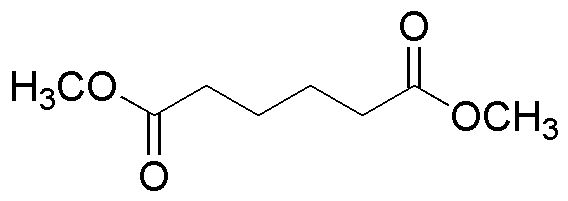Adipic acid dimethyl ester is widely utilized in research focused on:
- Polymer Production: This compound serves as a key intermediate in the synthesis of polyesters, which are essential in producing durable and flexible materials used in textiles and packaging.
- Plasticizers: It is used as a plasticizer in various applications, enhancing the flexibility and workability of plastics, particularly in the manufacturing of PVC products.
- Cosmetic Formulations: Adipic acid dimethyl ester is incorporated into cosmetic products as an emollient, providing moisture and improving the texture of creams and lotions.
- Pharmaceuticals: In the pharmaceutical industry, it acts as a building block for drug synthesis, contributing to the development of various therapeutic agents.
- Food Additives: It is also used as a food additive, where it can function as a flavoring agent or a stabilizer, enhancing the quality and shelf-life of food products.
General Information
Properties
Safety and Regulations
Applications
Adipic acid dimethyl ester is widely utilized in research focused on:
- Polymer Production: This compound serves as a key intermediate in the synthesis of polyesters, which are essential in producing durable and flexible materials used in textiles and packaging.
- Plasticizers: It is used as a plasticizer in various applications, enhancing the flexibility and workability of plastics, particularly in the manufacturing of PVC products.
- Cosmetic Formulations: Adipic acid dimethyl ester is incorporated into cosmetic products as an emollient, providing moisture and improving the texture of creams and lotions.
- Pharmaceuticals: In the pharmaceutical industry, it acts as a building block for drug synthesis, contributing to the development of various therapeutic agents.
- Food Additives: It is also used as a food additive, where it can function as a flavoring agent or a stabilizer, enhancing the quality and shelf-life of food products.
Documents
Safety Data Sheets (SDS)
The SDS provides comprehensive safety information on handling, storage, and disposal of the product.
Product Specification (PS)
The PS provides a comprehensive breakdown of the product’s properties, including chemical composition, physical state, purity, and storage requirements. It also details acceptable quality ranges and the product's intended applications.
Certificates of Analysis (COA)
Search for Certificates of Analysis (COA) by entering the products Lot Number. Lot and Batch Numbers can be found on a product’s label following the words ‘Lot’ or ‘Batch’.
*Catalog Number
*Lot Number
Certificates Of Origin (COO)
This COO confirms the country where the product was manufactured, and also details the materials and components used in it and whether it is derived from natural, synthetic, or other specific sources. This certificate may be required for customs, trade, and regulatory compliance.
*Catalog Number
*Lot Number
Safety Data Sheets (SDS)
The SDS provides comprehensive safety information on handling, storage, and disposal of the product.
DownloadProduct Specification (PS)
The PS provides a comprehensive breakdown of the product’s properties, including chemical composition, physical state, purity, and storage requirements. It also details acceptable quality ranges and the product's intended applications.
DownloadCertificates of Analysis (COA)
Search for Certificates of Analysis (COA) by entering the products Lot Number. Lot and Batch Numbers can be found on a product’s label following the words ‘Lot’ or ‘Batch’.
*Catalog Number
*Lot Number
Certificates Of Origin (COO)
This COO confirms the country where the product was manufactured, and also details the materials and components used in it and whether it is derived from natural, synthetic, or other specific sources. This certificate may be required for customs, trade, and regulatory compliance.

